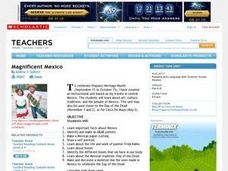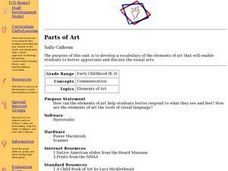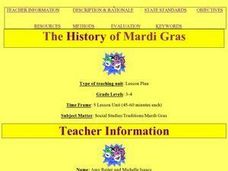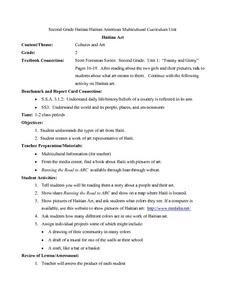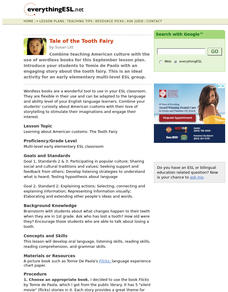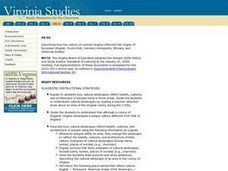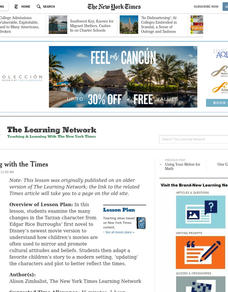Curated OER
Role Models- Grade 9
Ninth graders research Aboriginal role models. In this native studies lesson, 9th graders select leaders of the First Nations and Metis Nations of the Saskatchewan and research their contributions to society. Students create...
Curated OER
Describing Family - Lesson Plan
Students describe their family in their new language French. They use adjectives, and proper gender. Then they describe how the family is alike and different.
Curated OER
Food and Languages of the World
Students listen to the story "No Blue Food" in this lesson. They then discuss Allegra, the main character, and her hesitation to try new foods. They participate in a matching game in which they match cards to determine a fruit topping...
Curated OER
What Is Kwanzaa?
Students use vocabulary related to Kwanzaa. They identify main ideas and details related to the celebration of Kwanzaa and summarize information about Kwanzaa. They make picture books appropriate for first and second graders.
Curated OER
A Swahili Counting Book
Students give oral examples of similarities and differences between another culture and their own, then create a Swahili counting book using pictures from their own culture. Finally, students identify Swahili as a language spoken in Africa.
Curated OER
Everyday life in Spain
Students consider what life is like for Spanish young people. In this global studies lesson, students read and discuss excerpts from Children of the World: Spain. Students submit journal entries about everyday life in Spain.
Museum of Tolerance
Family Role Model Activity
What does is take to be a role model? Through grand conversation, and the use of books and a graphic organizer, scholars find out and apply the requirements to identify a role model within their family. They then journey through the...
Prestwick House
Into the Wild
Chris McCandless's life, adventures, and untimely death is the subject of Jon Krakauer's nonfiction work, Into the Wild. A thorough crossword puzzle includes quotes, characters, and key details from the book as clues.
Curated OER
Magnificent Mexico
Students complete a variety of activities in a unit about the art, culture, and traditions of Mexico. They read books about the Day of the Dead, create a skeleton puppet, and create a traditional Mexican tissue paper cutting. Students...
Curated OER
Poetry Appreciation – "The Raven"
Introduce your class to "The Raven" by Edgar Allan Poe with this series of activities, exercises, and worksheets. Class members examine an image, analyze a movie trailer, read a prose version of the poem, look up vocabulary, and pick out...
Curated OER
A Month of Mapping Literature
Explore the world through literature! With push pins to mark where each story came from, learners examine cultural differences, geographical location, and how those elements affect story content. This lesson could use deeper development,...
Curated OER
Parts of Art
Young scholars define and use new vocabulary associated with the elements of art. As a class, they brainstorm different ways in which we communicate with one another. In groups, they view different pieces of art from the Native American...
Curated OER
The History of Mardi Gras
Students gain knowledge about the history, traditions, and culture of Mardi Gras. They then apply the content to make related projects and complete assignments.
Curated OER
I am, you are, we are...
Pupils recognize that individual and groups have both common and different attributes and that each individual may be a member of many different groups. They choose a potato to paint a picture showing the character of their "friend"....
Curated OER
Haitian Art
Second graders watch "Running the Road to ABC" and observe a map where Haiti is located. They observe pictures of Haitian Art and describe the colors they see via the Internet. They then are assigned individual projects such as drawing a...
Curated OER
Tale of the Tooth Fairy
Students share social and cultural traditions and values. They develop listening strategies to explain what is heard.
Telefonica
What Did You Do During the Christmas Holiday?
When your English language learners return from winter break, find out how they spent it! This one-page worksheet reviews basic phrases and leisurely activities. After matching basic phrases with small picture illustrations, learners...
Curated OER
A River Mosaic#136
Students determine the meaning of culture as it applies to groups of people. They examine how immigration changes the cultural attribute of a geographic location. They design a Big Book that describes cultural mosaics.
Curated OER
Virginia Colony and England
Students identify how cultural landscapes reflect beliefs, customs, and architecture of people living in those areas. Then they identify that Virginia developed a unique culture different from that of England. Students also research...
Curated OER
Something From Nothing
Students listen to story Joseph Had A Little Overcoat to explore people from another culture and how one item can be used to make other items; students use scraps of fabric and other knickknacks to create pictures or toys.
Curated OER
International Festival: Venezuela
Students become familiar with the Venezuelan culture and geography. In this Venezuelan Festival lesson, students compare and contrast themselves to the people of Venezuela. Students participate in activities to understand the...
Curated OER
Holy Mole
Third graders explore the Mexican sauce Mole and the culture of Mexico. In this Mexican culture lesson, 3rd graders find Mexico on the map and access prior knowledge about the country. Students discuss Mexican foods....
Curated OER
LOOKING AT A CHARACTER
Second graders investigate self- and teacher-selected literature (e.g., picture books, nursery rhymes, fairy tales, poems, legends) from a variety of cultures. They re-enact and retell stories, songs, poems, plays, and other literary...
Curated OER
Swinging with the Times
Young scholars examine the many changes in the Tarzan character from Edgar Rice Burroughs' first novel to Disney's newest movie version to explain how student movies are often used to mirror and promote cultural attitudes and beliefs.








